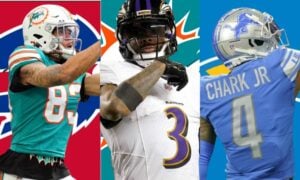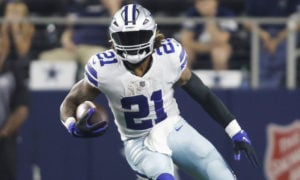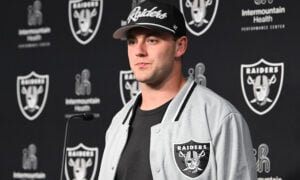Week Four Waiver Wire: A Closer Look at Two Potential Adds
Our own Ryan McDowell says his biggest advantage in dynasty is being more attentive than his league mates, especially on the waiver wire. Drafting is exciting. Trading is fun. Lineups decisions will make you pull your hair out. But waivers are a bit tedious, which is why you can win them. If you’re good at the thing no one else likes, you give yourself a big advantage.
This article is one step toward winning the waiver wire. Each week, I’ll talk about two players to add — one for shallower leagues (225-250 offensive players rostered) and one for deeper leagues (275-325 offensive players rostered). In some weeks, both players I discuss will be rostered in your leagues. I get that, and I welcome feedback about whether I should be digging deeper or shallower.
This is Clemson Week on the Waiver Wire column, as we’ll be highlighting a pair of wide receivers who spent their college careers in the shadows of Sammy Watkins, DeAndre Hopkins, Martavis Bryant and Dwayne Allen.
Shallow Leagues — Adam Humphries, WR TB
Humphries wasn’t an exciting prospect, either athletically or in terms of production. He’s not very big, weighing in at 195 pounds on 5-foot-10-inch frame. He ran a 4.53-second 40-yard dash at his pro day to go with below-average agility and explosion scores for his size. Think Willie Snead in terms of size and athleticism.
[am4show have=’g1;’ guest_error=’sub_message’ user_error=’sub_message’ ]
His collegiate production won’t knock your socks off either. Humphries had his best season as a junior, posting 41 receptions for 483 yards and two touchdowns behind fellow juniors Watkins and Bryant. He was overshadowed in his senior season by up-and-comers Mike Williams and Artavis Scott.
Tampa Bay signed Humphries as an undrafted free agent in 2015 and he was a pleasant surprise from the beginning. He was on the active roster in week one and he played 13 games on the season. He was the WR3 in both snaps (playing on 39.9 percent of the team’s offensive snaps) and targets (40). But he competed with Louis Murphy and Donteea Dye for opportunities, which made him a fantasy afterthought.
Things have changed in 2016. Humphries has separated himself from the WR3 committee and is challenging Vincent Jackson for the second WR option. Humphries is still third in snaps (74.8 percent of offensive snaps), but he’s second on the team in targets (25). Just as importantly, he’s making his opportunities count. He has a 72 percent catch rate (compared to 55 percent for Mike Evans and 41 percent for Jackson) and he leads the team with 8.0 yards per target.
Jackson turns 34 in January and he’s been as efficient as a late-career Andre Johnson. I don’t expect Humphries to take over the WR2 role this season. He’s running most of his routes from the slot, and I don’t see him replacing Jackson in two-WR sets. But he’s already established himself as Jameis Winston’s security blanket, which could mean a 100-target season and WR4 production.
Deeper Leagues — Jaron Brown, WR ARI
Brown is best known in fantasy circles as “the guy I almost play in DFS when I thought he was John Brown.” But after a long touchdown in week two and six targets in week three, Brown should be a hot waiver commodity in deeper leagues this week.
Compared to Humphries, Brown is an athletic marvel. He has classic receiver size, standing 6 feet 2 inches. He ran a 4.40-second 40-yard dash to go with solid explosion and agility scores. Think of a faster but less explosive Josh Doctson.
But like Humphries, Brown never carved out much of a role in Clemson’s passing game. His best season was his sophomore campaign. He was second on the team in receiving yards (405), behind DeAndre Hopkins and ahead of Dwayne Allen. He added 3 receiving touchdowns and 63 rushing yards on eight carries. He was the team’s fourth most productive receiver in his junior and senior seasons.
Brown has always been a role player in the NFL. He’s only topped 50 yards in a game twice, and one of those was a 2-catch, 78-yard performance in week two of 2016. But he’s established himself as the fourth receiver in Arizona and Michael Floyd is in the concussion protocol. Meanwhile, Brown received six targets in week three, which tied for the second most in his career.
Both Floyd and Brown will be unrestricted free agents after the 2016 season. Plus, Larry Fitzgerald is signed through 2017, but there have already been rumors that he’s retiring after 2016. If Brown performs well in a limited role in 2016, he should work his way into an opportunity, either in Arizona or elsewhere. He turns 27 in January, so he won’t be a quick flip candidate, but he could give you some fill-in production starting in 2017 (or sooner, if injury strikes the Cardinals’ receiving corps).
[/am4show]
- Dynasty Capsule: Miami Dolphins - January 26, 2019
- Dynasty Capsule: Buffalo Bills - January 21, 2019
- Dynasty Capsule: Carolina Panthers - January 21, 2018

































































